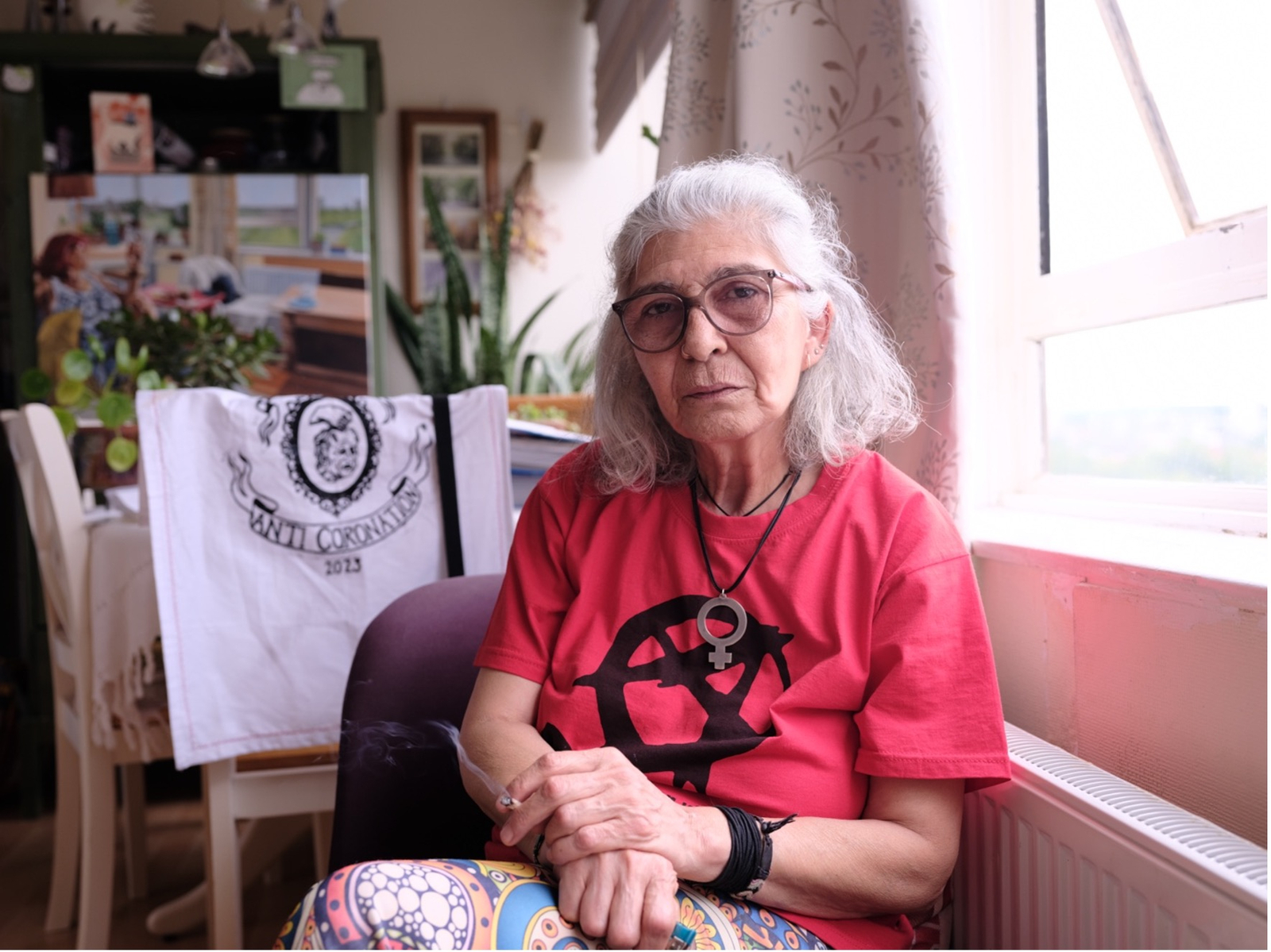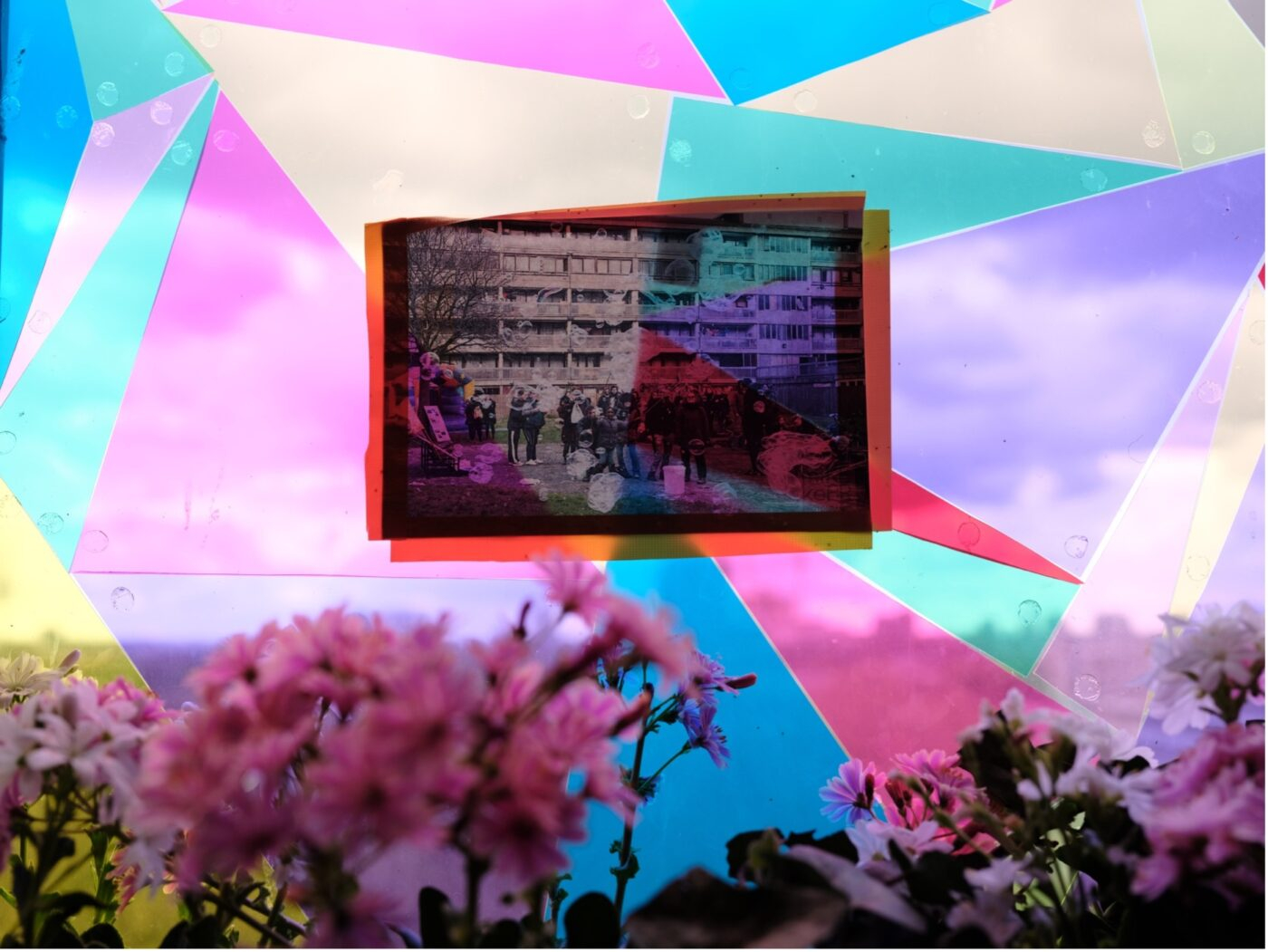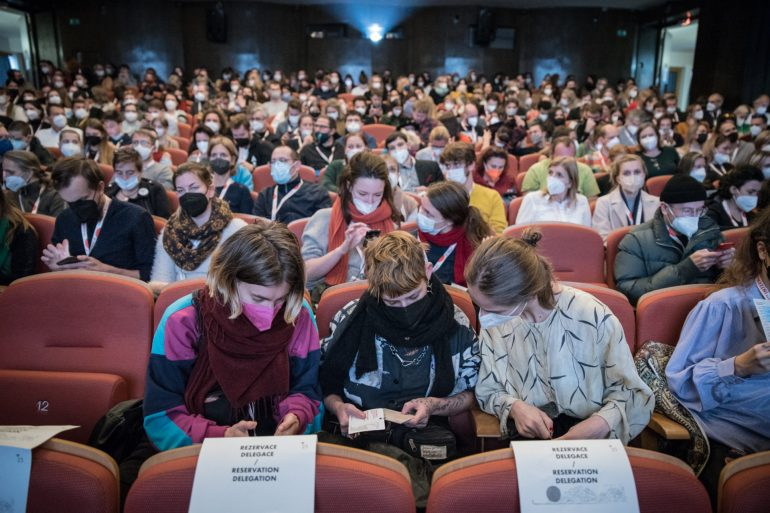The Aylesbury Estate was never popular. Soon after its opening in 1970, it was described as a “concrete jungle”, and an “impersonal creation.” The negative press grew even more in 1997 when Tony Blair decided to make his first speech as Prime Minister there, talking about an “underclass of people without any sense of shared purpose.” The choice of the venue was deliberate, as the Aylesbury had become a strong visual metaphor for destitution.
26 years later, in May 2023, activist and tenant Aysen Dennis – who has been defending her home from privatisation and demolition since 2001 – decided to host the exhibition Fight 4 Aylesbury in her own flat, to demonstrate that the need for decent social housing cannot be properly understood if one only looks from the outside in.
When I first walked into the flat, I felt extremely overwhelmed. The walls and rooms of Aysen’s flat were entirely covered in archival materials, including activism posters, brochures and photos of demonstrations, exposing the visitors to two decades of housing struggles. In usual circumstances, protest materials are temporary objects that only become visible during demonstrations. However, the Fight 4 Aylesbury exhibition embraces resistance as a visual asset from the start, turning these objects into live materials that reassert a statement that, 20 years later, remains as latent as ever: housing is a basic human right.

Contrary to the impersonal depiction of the Aylesbury in mainstream media, personal attachment seeps through the walls of Aysen’s place.
A big acrylic painting, depicting her a couple of years back – when she still dyed her hair striking red, hangs behind the kitchen table. The kitchen features a collage with photographs of herself, family, friends and her cats. Surfaces have been changed to embed Aysen’s own identity into the space. On her choice of locale, Aysen explains: “The exhibition wouldn’t have had the same impact elsewhere. I wanted people to see inside my flat, to show them how wonderful, spacious and beautiful it is.”

[The folders on the table contain some of the legal documentation that was used during the 2015 public inquiry.]

I moved from Brighton to London in September of 2022. Before that, I lived in Cardiff and Mexico City. From the moment I moved to London, I quickly realised that decent housing in a capital city is a privilege. On Facebook forums I joined before moving here, the average rent price now ranges between £800 to £1000, often not including bills. In March 2023, it was reported that London rent prices had surged by 20%.
After months of hearing personal stories about the cost of living crisis, seeing this exhibition felt almost cathartic. There is so much intimacy in the work, but as a viewer you don’t feel voyeuristic. Aysen greets guests like old friends, hearing them out, acutely aware that even though the exhibition is about her life, the issue at hand expands way beyond her reach.
“People came, cried, cuddled me and thanked me for opening up my flat,” she reminisces. “They are realising how important council housing is, and how we need more of it to be built in a decent way.” In London, to open up about your financial situation isn’t easy, as conversations about financial precarity can be swiftly weaponised. However, Aysen’s exhibition created a safe space where tenants could meet and talk about the existing challenges, whilst those supporting the cause could learn more about the housing crisis.
Targeted displacement
On my first visit to Aylesbury, I attended a lecture by Professor Paul Watt, which was part of the exhibition programming. Afterwards, I interviewed him to understand better the context that led to the current bureaucratic turmoil that the estate is in. The process of ‘regeneration’, which Paul aptly rephrases as ‘degeneration’ in his book Estate Regeneration and Its Discontents, can take years, and is essentially a slow process of “managed decline.”
Through convoluted plans that involve multiple phases and partners, tenants are pushed to the bottom of the decision-making hierarchy. Notting Hill Genesis, the developers in charge of the Aylesbury project, have set the estimated delivery date for 2036. This means that by the time it is finished, the whole project would have taken almost four decades, which has unsurprisingly led to dire consequences in the tenants’ wellbeing.
Paul uses the term “psychosocial degeneration” to describe an acute “displacement anxiety”, rooted in uncertainty. He explains: “The tenants know they will eventually have to move out, but they don’t know when, where, or what the prices will be. Moreover, once the demolition process starts in adjacent buildings, they get the discomfort of the dust and the noise, with health consequences that are not even acknowledged by the policy makers enacting these schemes.”
Despite not having a direct experience of physical displacement, the idea of displacement anxiety is something I can acutely relate to, as a migrant with a visa expiration date looming on the horizon. Perhaps this is the main reason I felt compelled by Aysen’s story, as she is very outspoken on who these schemes are targeting. For years, the media and the government have used Aylesbury Estate as a visually striking scapegoat to disregard complex systemic issues. It is easier to demonise and stigmatise its inhabitants, than to ask why more and more people need council housing.
“Whenever something negative happens, they take their anger and target vulnerable groups, minority ethnic groups and refugees like us,” Aysen explains. She moved with her sister Pinar to the UK from Turkey after the 1980 coup, which forced her to flee the country. Her personal story follows a pattern; coming to London was a political decision, and so is staying in the Aylesbury Estate until the very end. “If they move me to another accommodation across the street, I will go because I don’t want to lose my right to council housing. But if I move, it doesn’t mean I am giving up.”

Despite Aysen’s efforts to make her flat as warm and beautiful as possible, the reality is that the estate itself is in poor condition. As I walk around, I notice leaks in the corridors. On the inside highways, the wind is loud. As I go up the lift to get to Aysen’s flat, I hear the metal crunching. I start asking myself what would I do if I got stuck, as there is no emergency button either. The only people I come across during my time there are maintenance workers and builders from the adjacent building currently under construction. I barely see any tenants. The sight of boarded up doors is not easy to digest. There is so much loss and regret around, but more importantly, there is anger, reverberating through the halls.
Paul explains: “Councils argue that they are regenerating these areas to solve the housing crisis. But the process means that we just end up with empty flats for years, shrinking the amount of available property for social housing. Thousands of ex-tenants then have to be rehoused in temporary homes while their previous flats remain empty.”
Subscribe to shado's weekly newsletter
Exclusive event news, job and creative opportunities, first access to tickets and – just in case you missed them – our picks of the week, from inside shado and out.

Of the 4,200 new homes that the plan proposes, only 50% will be social rent or council housing. The rest will be private, representing a loss of over 800 homes. “It is not exactly solving the housing crisis,” says Paul. “It may be solving it for those who are very affluent, but not for those that are working class.”
The Notting Hill Genesis website, titled Aylesbury Now, features positive stories of community-building, inviting tenants to take part in the regeneration process through gardening initiatives and ideas workshops. However, it is likely that this is yet another PR strategy to appease the tenants that remain on the fence.
Paul explains that, in his experience, consultation processes with tenants are “not very clear, transparent or user-friendly.” They are simply a legal requirement which translates as an “extremely sanitised process.” He says: “What tenants are promised at the beginning of the consultation is not what they actually get. Some of the architects I interviewed for my book admitted that it is clear that it is a top-down exercise, skewed towards the developers and the council, who are the key stakeholders.”
Loss of community
A recurring theme throughout the exhibition is community; how physical spaces can help us create one, but also how, without the right support, it can swiftly be shattered. In the window in Aysen’s room there is a colourful mosaic. As the light streams in, it creates a beautiful effect, reflecting on the surfaces. In the distance, you can see the rest of Aylesbury, imposing and big, but also mesmerising.
When speaking to Aysen, I realised that these fragmented elements had a hidden meaning. She explains: “The collage is meant to represent the different communities we have in the Aylesbury estate. Sudanese, Somali, Cypriot, Latin communities, and many others.”

I remember when I first stepped into the estate. In one of its many buildings, there was a corner shop with men and women hanging out and chatting. There were also children coming back from the shops with their mothers. The design, with walkways and wide-open areas for pedestrians, forced people to cross paths constantly.
“In the summer,” Aysen remembers, “people would leave their doors open to let the air flow. They would come out to the corridor, bring their chairs and sit there to talk. It was alive.”
I can truly relate to the vital need for spaces where communities can be built. Isolation and fear were two strong emotions I experienced when I moved to London. Every instance of London’s detachment felt like a personal attack. I kept resenting myself for moving; reminiscing the many homes I had left behind.
The idea of building a community from scratch seemed unfathomable, and I spent the first three months agonising inside my flat – my safe space – wondering when I would be brave enough to step outside. Eventually, I found that strength through a group of Latinx poets, and the similarity in our experiences made me feel more capable of building a home in London.
However, the community space that we were using to meet up was recently reclaimed by the council, so we have been struggling to find free spaces to meet.
In a similar vein that follows London’s approach of gentrification, the proposed redesign for Wendover House (where Aysen currently lives) is very different to what existed before. The new build will include slim hallways and private balconies, with so-called communal areas that are not solely for residents, but also for general passers-by, essentially stripping away the sense of kinship between neighbours that the estate naturally allowed. Aysen emphasises that her feeling of loss is not for just the building itself, but for what it represents. “Now, every boarded door reminds me that I am one of the few people left. How long can we resist?”
Resistance
One of the brochures in the Aylesbury Now website lists three options for Aylesbury tenants:
- Move to an existing property
- Move to another council home
- Move to a council home outside of Southwark
Simply put, there is no real choice to stay, as the redevelopment choice has already been made. However, the Fight 4 Aylesbury exhibition shows an alternative option: 4. Resist. The exhibition was created and curated as an active collaboration between tenants, ex-tenants, campaigners, academics and artists. The funds needed for the materials were raised through an evening of music at Avalon Café.
Despite the intricacies of the topic at hand, the exhibition itself is full of hope, and it is testament to an alternative path, where solidarity and care overtakes greed and profit. Its aim, in Aysen’s words, is to “prolong the process long enough for the developers to move away from the project, forcing them to refurbish rather than demolish.”
Before finishing the interview, I ask Aysen if there is anything else she would like to add. She replies immediately. “I want to acknowledge my sister Pinar, who passed away in 2019. During all those years of campaigning, she was my force.”
Aysen reminds me that nothing is possible alone. Inside these walls, individual stories do not exist in isolation. Like the collage in Aysen’s bedroom, multiple lives and migrant stories converge in a single location. Stories that made the United Kingdom what it is today, and that, despite the government’s efforts to invisibilise them, keep on fighting and resisting.
I leave the Aylesbury Estate knowing that the best view of London is not from The Shard.

What can you do?
- Follow @fight4aylesbury on Instagram to learn about the project’s latest developments
- Donate to Aysen’s crowdfunding campaign
- Read Estate Regeneration and Its Discontents: Public Housing, Place and Inequality in London by Paul Watt to learn more about the policies behind London’s state-led gentrification project
- Join housing struggle associations such as Homes for All, Defend Council Housing or Why Demolish?
- Read this article by Leah Cowan: What is the Hostile Environment?
- Read more articles on the topic of migration HERE














